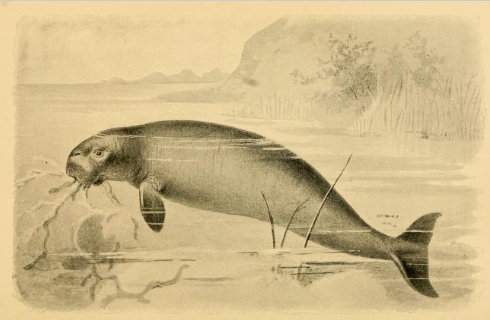|
| 질의: Grey whale | 결과: 196번째/225 | |
Steller's sea cow (Hydrodamalis gigas), extinct
| 제목: | Steller's sea cow (Hydrodamalis gigas), extinct
| | 올린이: | Wiki Photos (---@---.---)
| |

| 해상도: 490x320
파일크기: 96599 Bytes
등록시간: 2017:02:24 10:21:48
|
Description
English: Steller's Sea Cow
Date 1893
Source Extinct monsters : A popular account of some of the larger forms of ancient animal life
Author Hutchinson, H. N. (Henry Neville), 1856-1927
Source: https://commons.wikimedia.org/wiki/File:Extinct_Monsters_(1893)_Sea_Cow.png
Steller's sea cow (Hydrodamalis gigas) is an extinct species of sirenian that was found exclusively around the Commander Islands at the time of their discovery, which are situated in the Bering Sea between Alaska and Russia. Its closest living relative is the dugong (Dugong dugon), which is the sole surviving member of the Dugongidae, of which Steller's sea cow was also a part. It was among the largest mammals other than whales to have existed into the Holocene epoch, reaching weights of 8–10 metric tons and lengths of 9 metres. Order: Sirenia, Family: Dugongidae, Subfamily: Hydrodamalinae, Genus: Hydrodamalis, Species: Hydrodamalis gigas Zimmermann, 1780
Synonyms:
Hydrodamalis stelleri Retzius, 1794
Rytina manatus borealis Illiger, 1811
Rytina borealis Illiger, 1815
Rytina cetacea Illiger, 1815
Rytina stelleri Desmarest, 1819
Rytina borealis Cuvier, 1836
Rytina stelleri Burmeister, 1837
Rytina gigas Gray, 1850
Manati gigas Zimmermann, 1780
Manati balaenurus Boddaert, 1785
Manati borealis Link, 1795
Trichechus manatus borealis Gmelin, 1788
Trichechus borealis Shaw, 1800
Sirene borealis Link, 1794
Nepus stelleri Fischer, 1814
Stellerus borealis Desmarest, 1822
Haligyna borealis Billberg, 1827
Manatus gigas Lucas, 1891
|
댓글 |
|---|
| | 손님 |
|
Scientific Name: Hydrodamalis gigas (Zimmermann, 1780)
Common Names: Steller's Sea Cow, great northern sea cow |
^o^
동물그림창고 똑똑전화 누리집
^o^
|
|
|